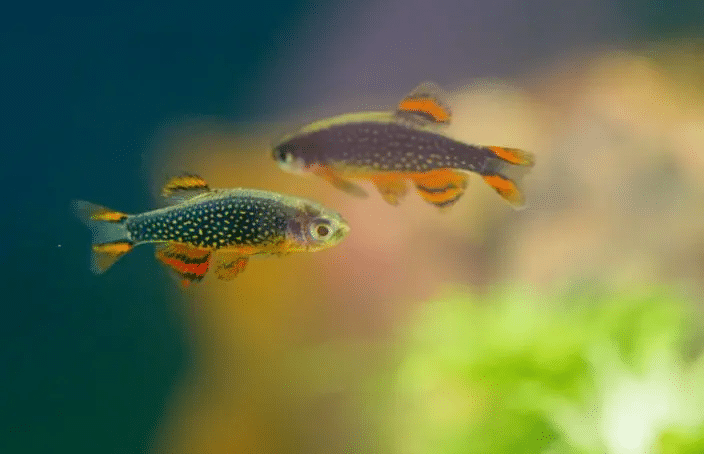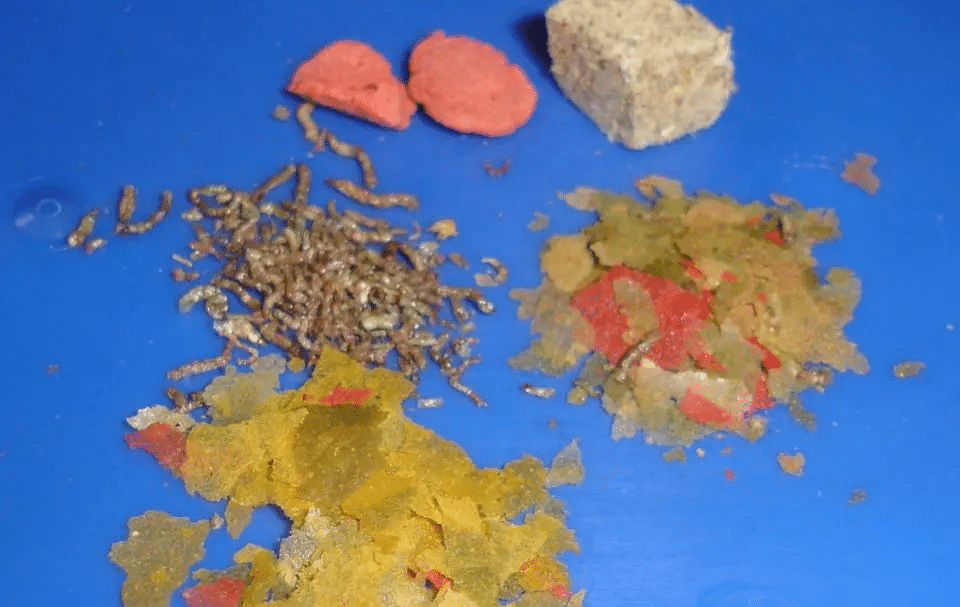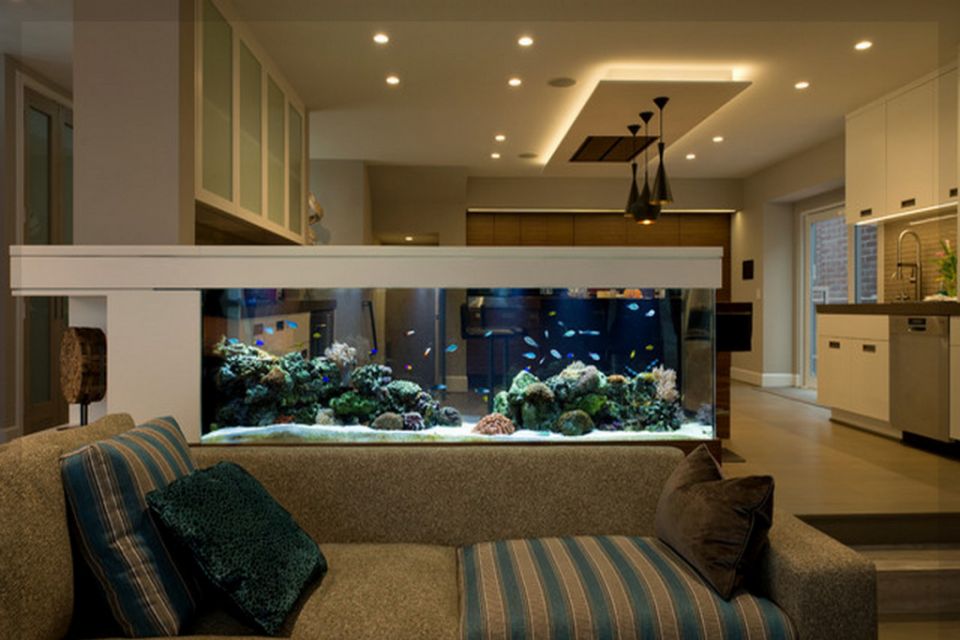
The fish, which can grow up to 2.5 centimetres, belong to the genus of carp fish. Danio margaritus is a very popular ornamental fish because of its easy care and beginner friendliness: it can also cope with slightly cool water and room temperature and does not necessarily need an aquarium heater. At the same time it delights its owners with its splendid colours and its impressive behaviour when looking for a partner.
Even though Danio margaritatus are generally sold as easy to keep beginner fish in pet shops, there are a few things to keep in mind when keeping them. In the following aquaristic guide article we will tell you more.
Table of Contents
The Danio margaritatus bear shortly presented
- Danio margaritatus bearblings are popular ornamental fish from the Southeast Asian region (Myanmar and Thailand)
- The base colour is bluish and has light spots
- Size: up to 2,5 cm
- Age: up to 3 years
- The animals are easy to keep, beginner-friendly, easy to care for
- Character: somewhat shy, peaceful
- loves dense vegetation with water plants
- Aquarium size: 60 litres capacity is recommended
- also gets by with somewhat cool water temperatures and without heating
- good to socialize with other bearblings, snails, dwarf crabs, or shrimps
- feeds on live or frozen food, such as mosquito larvae or microworms

Where do Danio margaritatus occur?
Originally, it was assumed that the Danio margaritatus bear is only found in its original habitat in Thailand, but in the meantime other areas have been found. Danio magaritatus is native to some areas of Thailand and Myanmar. There, the Danio margaritatus bear lives in higher, slowly flowing and stagnant waters. Danio margaritatus feels especially comfortable in slightly cool and alkaline water. The natural habitat is characterized by many stones and relatively dense planting.
Danio margaritatus bearblings and the big delivery bottleneck
Shortly after its discovery, Danio margaritus was also offered in German pet shops, where the demand increased rapidly. The Danio margaritatus bear became so popular that the sale to buyers had to be rationed to save Rasbora Galaxy from extinction. There was sometimes a call from a British magazine dealing with aquaristics that only people seriously interested in keeping or breeding fish should get Danio margaritatus.
In the meantime, the offspring is very successful, so the supply shortage of Danio margaritatus bearblings could be eliminated. In the meantime, other habitats in Southeast Asia have also been discovered.

Portrait of Danio margaritatus bear
The name margaritatus means “adorned with pearls” and so the name Danio margaritatus bear is also derived from the fact that the Danio margaritatus has bright spots in its plumage.
Danio margaritatus is a very popular aquarium fish due to its colouring and its small size. It has bright spots on its bluish skin, similar to the colouring of a guinea fowl. Its fins are striped red and black lengthwise. The back is light brown in colour and the underside of the belly is reddish. Female guinea fowls have a weaker colouring than males and are thicker. Their anal fin is either transparent or only slightly coloured. Males and females can be easily distinguished.
Unfortunately, in the pet shop you can always get Danio margaritatus that look quite worn out. This is due to the insufficient feeding by the pet shops. To replenish these fish and save them from dying, they need sufficient live food, such as cyclops, Artemia and mosquito larvae.

Which water characteristics does the Danio margaritatus prefer?
Danio margaritatus do not place too great demands on the water quality in the aquarium. The aquarium water should at best be characterised by the following values:
Temperature 19° – 25° C
pH value 6.8 – 7.5
Total hardness (dGH) 5° – 18° d
When you look at the optimal water values, you immediately notice that the animals like it relatively cool. At a temperature of only 19-25°C many South American species certainly do not feel comfortable, which is why a socialization should be avoided. Additionally the animals prefer a slightly alkaline water.

How do you keep the Danio margaritatus in the aquarium?
Danio margaritatus are schooling fish: the school gives the shy animals a feeling of security and contributes significantly to the social behaviour of the animals. For this reason it is recommended not to keep a group of less than 10 animals when keeping Danio margaritatus in the aquarium.
If the swarm is too small, i.e. there are too few Danio margaritatus in the aquarium, this is mainly noticeable by the extreme shyness of the animals. They then literally hide themselves only in the plant bushes and are hardly to be seen. Generally the animals are quite shy during the acclimatisation period, later they develop a lively, peaceful species.

Socialization of Danio margaritatus in the aquarium
The peaceful Rasboras Galaxy can be easily socialized with other small bearblings, as well as peaceful and not too hectic fish like Endler Guppies. Only the socialization with large species should be avoided, as this would again make the animals shy and the very small specimens could easily end up as a snack.
Snails, dwarf crabs or shrimps are other species that can be easily socialized with the guinea fowl, because the Danio margaritatus no longer eat them once they reach a certain size and the animals do not get in each other’s way in the tank.

Danio margaritatus fundamentally populates the upper and middle basin area of the aquarium and needs sufficient space for swimming. Therefore, when keeping Rasbora Galaxy you should not keep a 60 liter aquarium with the standard dimensions of 60x30x30cm.
In forums one often reads that even nano-aquariums with a tank volume of 30 litres or more are sufficient for keeping the animals: we think this is absolutely not in keeping with the nature of this swimming fish and should be avoided completely.
A large part of the Rasbora Galaxies available on the market are wild catches. To keep the species in the wild, you should therefore prefer to buy fish from offspring. The prices for Danio margaritatus should be between 4 and 8 Euros per animal.

Planting & structure of the aquarium
The Danio margaritatus bear requires a dense planting as a retreat, but also hiding places in the form of bogwood roots and stones should be given for the Rasbora Galaxy and are gladly accepted by it.
The trick is to provide sufficient hiding places and retreats with the planting and other decoration and at the same time to ensure a large enough swimming area for the swimming guinea fowl. It has therefore proved to be a good idea to leave the planting on the outer edges and to place stones and roots in such a way that they do not get into the swimming area.

Suitable plants are mosses (for spawning) or pearlwort. In addition, a dark substrate and not too bright lighting are ideal – especially the latter requirement can be easily achieved with dimmable LEDs.
Floating plants on the surface of the water are also very well suited for the insulation of the light, especially when fluorescent tubes are used. Quite contrary to the assumption, the shy animals will show up much more often, the more hiding places are offered: the Danio margaritatus then feel safe and comfortable.

Which food does the Danio margaritatus prefer?
The diet of the Danio margaritatus is relatively simple. It eats anything that fits in its mouth, which is not too big.
Danio margaritatus prefers to eat small live animals, such as Cyclops, Artemia or Daphnia, but is also happy to accept frozen food or dry food. By the way, we will show you how the different types of aquarium fish food differ from each other in our guide article.

The Danio margaritatus bear eats only the food that swims in the middle water depth. Food on the water surface or on the bottom of the aquarium is not accepted by Rasbora Galaxy. Therefore, regular feeding, at best daily in small portions, is advisable.
In fact, the little ornamental fish has a truly blessed appetite: Danio margaritatus eats everything he can find and everything that fits in his mouth, especially in the early days in his new home. This is often due to poor feeding in pet shops and on the long journey to Germany.
If Danio margaritatus are fed regularly and in a varied way also with live food, the animals can live up to 3 years.

How to breed Danio margaritatus in an aquarium?
Fully grown and well fed Danio margaritatus can also be bred in community aquariums, as they show a mating behaviour.
The males courted very distinctly for the favour of the females. They stand opposite each other and turn in a small circle. The female, willing to reproduce, is followed through the entire aquarium, right into the plant thicket. The spawn is later deposited in this thicket.

The female lays up to 6 eggs daily and the young hatch after 2 to 3 days. Planting is indispensable, as it not only offers the Danio margaritatus a place of retreat – to protect them from other fish – but is also needed for spawning.
Without planting, the Danio margaritatus cannot recover from the strenuous courtship display of the males. This permanent stress leads to the loss of its colourfulness, to diseases and finally to the animals’ failure. Without dense planting, the Danio margaritatus will also stop breeding completely.

Some aquarists put a spawning rust on the bottom of the tank and cover it with moss. This makes it easier for the females to lay eggs.
If the Danio margaritatus are to be reared, it is advisable to feed the fish generously for a few days and then to place them in a separate breeding tank. The water level in the spawning tank should be low and the tank very densely planted.
Shortly after spawning, the large parent fish should be fished out because they tend to eat the spawn. As soon as the juveniles of the Rasbora Galaxy have completely consumed their yolk sac and the small Danio margaritatus begin to swim around in the tank, they can be fed plankton, fine-grained granules, dust food or infusoria. Later they can be switched to nauplii. When liquid food is given, care should be taken to change the water regularly.
Conclusion: keeping Danio margaritatus in the aquarium is not difficult
The small Danio margaritatus bear cubs enrich every aquarium with their striking appearance. The relatively easy care and uncomplicated breeding make Danio margaritatus an ideal aquarium fish, which is also suitable for beginners.
Danio margaritatus is a small, beautiful ornamental fish that has made the hearts of many aquarium fans beat faster since its appearance. Still today Danio margaritatus is a very popular mini fish, often sold out in pet shops.
Its blue colour with black and red fins sets great accents in any aquarium. When it swims briskly through the tank and is always busy showing off, it is a beautiful sight. Its peaceful and agile nature makes it a suitable companion for numerous other mini fish and invertebrates. He is tolerant of changing water values and his offspring is absolutely recommendable and is fun for many fish lovers.
Do you already keep Danio margaritatus in your aquarium and are you satisfied with the animals? Show us your pictures in the comments.



